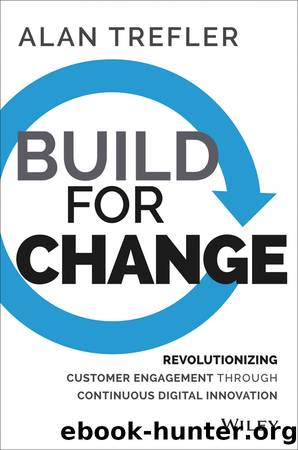Build for Change by Trefler Alan

Author:Trefler, Alan [Trefler, Alan]
Language: eng
Format: epub
ISBN: 9781118930281
Publisher: Wiley
Published: 2014-05-16T00:00:00+00:00
Getting beyond Business Process Modeling
How do you meet these changing customer expectations in the context of process? What is the starting point for creating genuine customer processes?
Just as businesses focus on data for the sake of data, just as they miss intent time and again, businesses also tend to impose broken, inside-out processes on their customers. Even the best of these, the ones that make customer experiences better than their competitors, are more about the business than the customer. Few businesses rethink their processes completely from the customer perspective. Such is the classic problem of business process modeling, which tends to document the existing series of internal steps in a business line or function or channel. And what happens when there’s a new channel? More often than not, those internal steps are simply replicated, creating an additional silo to foster disconnected customer engagement.
How do you avoid the trap of traditional business process modeling? To put your customer into sharper view, you need to begin thinking about processes, and continue to think about them, with one question in the forefront: How does my customer want to engage with me? Start there, and you will never make the mistake of not assuming that your customers will naturally want to be able to move from a social media interaction (e.g., a rant or rave on Twitter) to an online chat, to a call center engagement, to a visit to a physical retail location.
This is not to say that you should ignore your channels, but rather that you must design in ways that unify how they work for your customers. Right now, mobile and social channels are the big news. Indeed, they are powerful and disruptive. But they cannot be hived off within your larger enterprise. They must not be constructed as silos, somehow exempt from everything else and doing things their own way. Your perspective needs to be that they are just another way customers deal with your company, because that is how customers see them. And they have to be invisible as channels, because that is how Gen D will (not) see them.
Once you’re there, you can begin to design customer processes that put data and intent to work together.
Where do the obstacles lie? Peter Burris writes, “The challenge of systematically understanding and serving customers derives from the fact that increasingly customers enjoy the freedom to take whatever journey suits their perceived need. Efforts to tighten down process models for engaging customers ultimately are frustrated by the complexity of empowered customer scenarios and choices: When customers are on the other end of engagement, are free to move around, and hold market power, you cannot design and implement a successful end-to-end engagement process.”3
True, if you are stuck in the rut of using technology in the traditional ways. The good news, though, is that technology is fully capable of adapting to allow you to manage real-time engagement at a process level. Most technologists say otherwise, because of the way they think . . . not because of the technology itself.
Download
This site does not store any files on its server. We only index and link to content provided by other sites. Please contact the content providers to delete copyright contents if any and email us, we'll remove relevant links or contents immediately.
Hit Refresh by Satya Nadella(9036)
The Compound Effect by Darren Hardy(8806)
Change Your Questions, Change Your Life by Marilee Adams(7633)
Nudge - Improving Decisions about Health, Wealth, and Happiness by Thaler Sunstein(7612)
The Black Swan by Nassim Nicholas Taleb(7009)
Deep Work by Cal Newport(6873)
Daring Greatly by Brene Brown(6443)
Rich Dad Poor Dad by Robert T. Kiyosaki(6397)
Principles: Life and Work by Ray Dalio(6201)
Man-made Catastrophes and Risk Information Concealment by Dmitry Chernov & Didier Sornette(5921)
Playing to Win_ How Strategy Really Works by A.G. Lafley & Roger L. Martin(5911)
Digital Minimalism by Cal Newport;(5661)
Big Magic: Creative Living Beyond Fear by Elizabeth Gilbert(5609)
The Myth of the Strong Leader by Archie Brown(5420)
The Slight Edge by Jeff Olson(5346)
Discipline Equals Freedom by Jocko Willink(5276)
The Motivation Myth by Jeff Haden(5154)
Stone's Rules by Roger Stone(5026)
The Laws of Human Nature by Robert Greene(4995)
